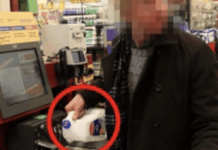A twitter post shared by one of our subscribers:
Disclaimer: We at Prepare for Change (PFC) bring you information that is not offered by the mainstream news, and therefore may seem controversial. The opinions, views, statements, and/or information we present are not necessarily promoted, endorsed, espoused, or agreed to by Prepare for Change, its leadership Council, members, those who work with PFC, or those who read its content. However, they are hopefully provocative. Please use discernment! Use logical thinking, your own intuition and your own connection with Source, Spirit and Natural Laws to help you determine what is true and what is not. By sharing information and seeding dialogue, it is our goal to raise consciousness and awareness of higher truths to free us from enslavement of the matrix in this material realm.
 EN
EN FR
FR



























Does anyone know?
More cracks appear in the fairy tale we are forced to live. Again, the "Emperor's New Clothes" tale by Hans Christian Anderssen, comes to mind.
Here's the document mentioned by Jon Rappaport:
https://archive.org/details/cdc-2019-novel-coronavirus-2019-n-co-v-real-time-rt-pcr-diagnostic-panel-eua-cdc-panel-ifu/page/39/mode/2up
On page 42 is the text present that is quoted by Jon Rappaport in the tweet:
Analytical Performance:
Limit of Detection (LoD):
LoD studies determine the lowest detectable concentration of 2019-nCoV at which approximately 95% of all (true positive) replicates test positive. The LoD was determined by limiting dilution studies using characterized samples.
The analytical sensitivity of the rRT-PCR assays contained in the CDC 2019 Novel Coronavirus (2019-nCoV) Real-Time RT-PCR Diagnostic Panel were determined in Limit of Detection studies.
* Since no quantified virus isolates of the 2019-nCoV were available for CDC use at the time the test was developed and this study conducted, assays designed for detection of the 2019-nCoV RNA were tested with characterized stocks of in vitro transcribed full length RNA *
(N gene; GenBank accession: MN908947.2) of known titer (RNA copies/µL) spiked into a diluent consisting of a suspension of human A549 cells and viral transport medium (VTM) to mimic clinical specimen. Samples were extracted using the QIAGEN EZ1 Advanced XL instrument and EZ1 DSP Virus Kit (Cat# 62724) and manually with the QIAGEN DSP Viral RNA Mini Kit (Cat# 61904). Real-Time RT-PCR assays were performed using the Thermo Fisher Scientific TaqPath™ 1-Step RT-qPCR Master Mix, CG (Cat# A15299) on the Applied Biosystems™ 7500 Fast Dx RealTime PCR Instrument according to the CDC 2019-nCoV Real-Time RT-PCR Diagnostic Panel instructions for use.
On page 39 it says: pay attention to the last sentence!
Limitations
• All users, analysts, and any person reporting diagnostic results should be trained to perform this
procedure by a competent instructor. They should demonstrate their ability to perform the test
and interpret the results prior to performing the assay independently.
• Performance of the CDC 2019-nCoV Real-Time RT-PCR Diagnostic Panel has only been established
in upper and lower respiratory specimens (such as nasopharyngeal or oropharyngeal swabs,
sputum, lower respiratory tract aspirates, bronchoalveolar lavage, and nasopharyngeal
wash/aspirate or nasal aspirate).
• Negative results do not preclude 2019-nCoV infection and should not be used as the sole basis
for treatment or other patient management decisions. Optimum specimen types and timing for
peak viral levels during infections caused by 2019-nCoV have not been determined. Collection of
multiple specimens (types and time points) from the same patient may be necessary to detect
the virus.
• A false-negative result may occur if a specimen is improperly collected, transported or handled.
False-negative results may also occur if amplification inhibitors are present in the specimen or if
inadequate numbers of organisms are present in the specimen.
• Positive and negative predictive values are highly dependent on prevalence. False-negative test
results are more likely when prevalence of disease is high. False-positive test results are more
likely when prevalence is moderate to low.
• Do not use any reagent past the expiration date.
• If the virus mutates in the rRT-PCR target region, 2019-nCoV may not be detected or may be
detected less predictably. Inhibitors or other types of interference may produce a false-negative
result. An interference study evaluating the effect of common cold medications was not
performed.
• Test performance can be affected because the epidemiology and clinical spectrum of infection
caused by 2019-nCoV is not fully known. For example, clinicians and laboratories may not know
the optimum types of specimens to collect, and, during the course of infection, when these
specimens are most likely to contain levels of viral RNA that can be readily detected.
• Detection of viral RNA may not indicate the presence of infectious virus or that 2019-nCoV is the
causative agent for clinical symptoms.
• The performance of this test has not been established for monitoring treatment of 2019-nCoV
infection.
• The performance of this test has not been established for screening of blood or blood products
for the presence of 2019-nCoV.
• This test cannot rule out diseases caused by other bacterial or viral pathogens.
THIS TEST CANNOT RULE OUT DISEASES CAUSED BY OTHER BACTERIAL OR VIRAL PATHOGENS (!?)
Is Derek Knauss Dr. Derek Knauss the clinical scientist and immunologist-virologist at a southern California laboratory? I'm trying to find out whether he's a real person or just a fictitious name. Can anyone help please?